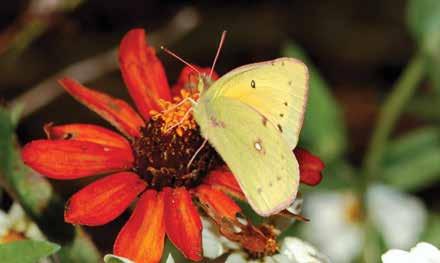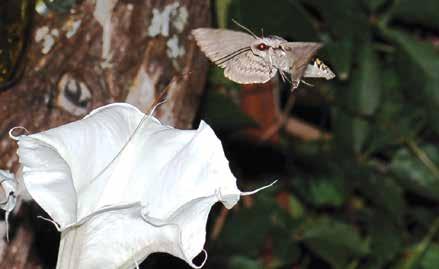
3 minute read
Flower Power in your garden
Flower Power in your Butterfly Garden
Butterflies flit aimlessly from flower to flower. That’s a problem for plants which need a pollinator’s repeat visits to reproduce. Fortunately, plants have many ways to manipulate pollinators into the correct behavior. First, nectar is produced solely for the purpose of attracting pollinators and bribes them to return over and over for another sweet taste. More sophisticated selection strategies can determine which pollinators come to any particular flower.
Flowers as Gatekeepers
Flowers are the reproductive organs of plants and bloom in many forms such as the flat petals of cone flowers, the short tubes of mints, the deep throats of lilies and flat multi-flowered umbels like members of the carrot family. Why wouldn’t a simple white daisy suffice for all plants? The amazing variety of colors, sizes and shapes is the flower’s way of communicating with pollinators, telling them either “come on in” or “go away.” Encouraging favorite pollinators to be faithful maximizes the flower’s reproductive efficiency because the pollinator must go from Zinnia to Zinnia to Zinnia to perform fertilization. If it visits a Zinnia, then a Marigold, then a Cleome, then all of those flowers’ pollen has been wasted and all are still unfertilized.
Flower Power Ploys
The flower’s shape determines whether the pollinator can balance on the flower and reach the nectar. Color not only attracts pollinators, it can select which pollinators since bees can’t see the color red. A red flower is invisible to them and not a target for pollination. Conversely, hummingbirds are attracted by the color red so red flowers and red plastic feeders will attract them to nectar’s sweet bribe. The flowers’ odor is an attractant, especially for foraging bees. Odor can also be very specific if mimicking the aroma of a particular female bee’s pheromones. Males of the same species will be attracted and will serve as pollinators as they attempt to mate with flowers that look and smell like a female bee.
Inviting Butterflies
Color or fragrance are not primary attractants for butterflies, but flower shape and nectary depth determine which flowers will be used. A flower like Echinacea (Cone Flower) or Rudbeckia puts out the welcome mat for butterflies by providing a flat surface for landing and balancing those proportionally huge wings plus for tasting the flower with the tastebuds in their feet. Closely packed small flowers like Lantana and Butterfly Bush can also provide a flat surface. Because butterflies have relatively short tongues, nectaries must be shallow to ensure that the nectar is within reach. Flowers such as Milkweeds, Zinnia, Sunflowers, Tithonia (Mexican Sunflower), and Coreopsis also meet the butterflies’ criteria.
Deep Throat Speaks
The deep placement of a lily’s nectar doesn’t deter most pollinators that can simply stroll down the long tube to the nectar pot. However, butterflies can’t fold their wings to make the journey so lilies are telling the short-tongued, big-winged butterflies to “Just leave me alone.” Additionally, many lily-shaped flowers bloom at night when bees and butterflies are asleep. Nocturnal lilies are telling both bees and butterflies that they are not welcome. Instead, they emit an intense perfume in the evening to call in the night flying Hummingbird Moths. Again, the flower chooses its pollinator. This Southern Dogface Sulphur will return to zinnias because the flat surface and shallow nectaries are “perfect”.
Giant Swallowtails, like pictured left, favor Tithonia (Mexican Sunflower) for their large size and composite flowers.


This night-blooming Datura can accommodate the Carolina Hummingbird Moth’s 10-inch-long tongue.
LENORA LARSON Butterfly Maven
A Marais des Cygnes Master Gardener, Lenora is a member of the Idalia Butterfly Society and Kansas Native Plant Society. She gardens in the clay soil and cruel winds of Paola, KS. She may be contacted at lenora.longlips@gmail.com.







